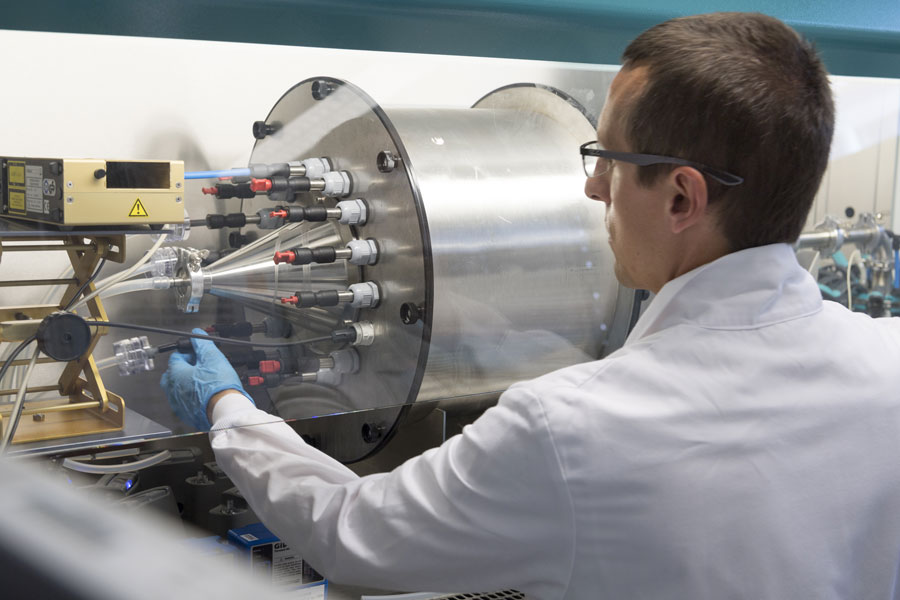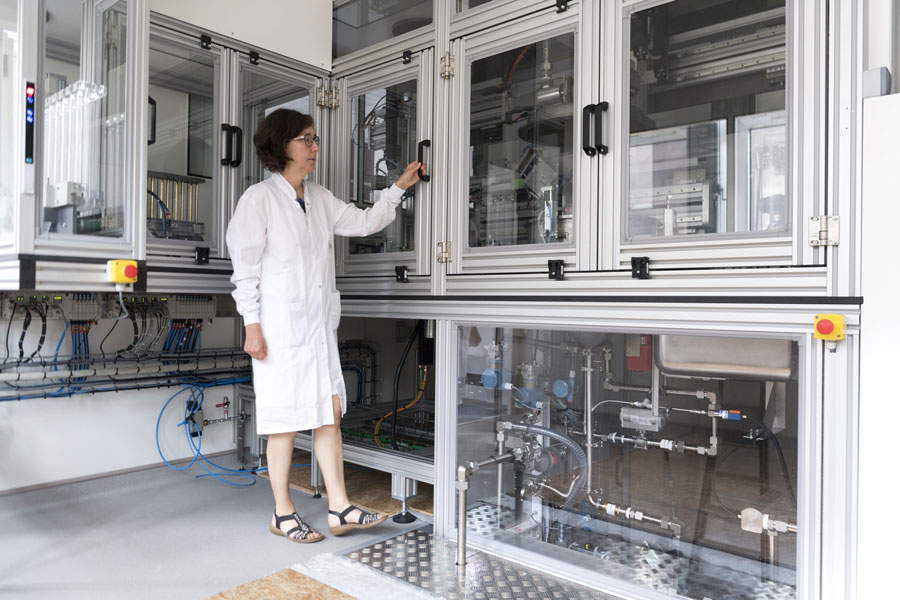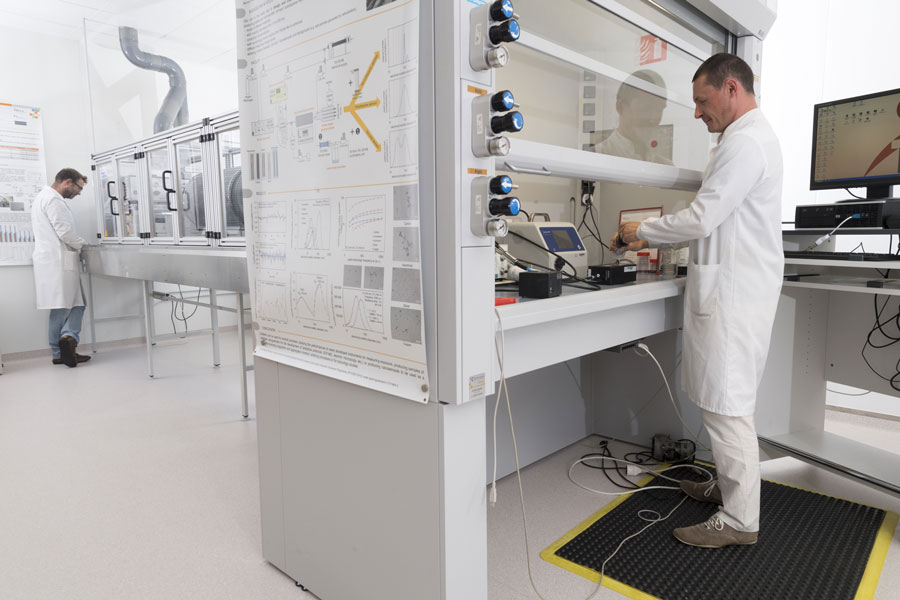Pollutant Metrology
The aim of works of the Pollutants Metrology Department relates to the prevention of occupational diseases. They mainly concern the development and validation of methods and techniques for the assessment and characterization of occupational exposure to gaseous pollutants and aerosols of chemical and biological agents in the atmosphere of workplaces
Pollutant metrology facilities
The department has facilities for generations of controlled atmospheres making it possible to reproduce as much as possible the working atmospheres to develop methods and tools in the most representative situations of real situations for organic gases and vapors, semi-volatile aerosols, nanoparticles, particles and fibers, biological aerosols… Providing simple methods, easy to use, reliable, robust and the least expensive possible is a priority objective of the Pollutants Metrology department. All the methods are available in the MétroPol database available on the website www.inrs.fr.

© Louis Martin for INRS
Publications
- Frederic CLERC, Jérôme LAVOUE, Lawrence JOSEPH, Tracy KIRKHAM, Hugh DAVIES, France LABRECHE, Peter KNOTT, Gautier MATER. Expostats: A Bayesian toolkit to aid the interpretation of occupational exposure measurements. 2018 ; Annals of Work Exposures and Health
- Sebastien BAU, Olivier WITSCHGER. Mesure en temps réel de la concentration en nombre d'un aérosol submicronique au moyen d'un compteur de noyaux de condensation. 2019 ; Fiche MétroPol
- Williams ESTEVE. Protocole de mise au point des méthodes de prélèvement surfacique et d'analyse des substances chimiques sur les surfaces de travail. 2019 ; Fiche MétroPol
- Frederic CLERC, Andrea EMILI, Gautier MATER. AltrexChimie, a software for the management and the interpretation of occupational exposure measurements to chemical substances. 2020 ; International Journal of Environmental Research and Public Health
Metrology of exposure to organic pollutants
The laboratory is developing methods for the qualitative and quantitative analysis of occupational exposure by organic compounds: exposure by inhalation and skin exposure. All the methods developed in the laboratory, on benches for generating gases, vapors and semi-volatile organic aerosols, are systematically validated in real situations, in companies. The work focuses on improving existing methods, developing new approaches and new devices: surface sampling by proposing a stabilized methodology, sensor for measuring individual exposure such as for example to ozone, new sampling support specific to nitrous oxide, measurement of semi-volatile aerosols, passive sampling of pollutants, supercritical CO2 desorption. The laboratory has a fleet of devices adapted to the needs and corresponding to the techniques conventionally used by exposure measurement laboratories.

© Serge Morillon - INRS
Publications
- Marianne GUILLEMOT, Benoit OURY, Sandrine MELIN. Identifying thermal breakdown products of thermoplastics. 2017 ; Journal of Occupational and Environmental Hygiene
- Benjamin SUTTER, Eric PELLETIER, Morten BLASKOWITZ, Christel RAVERA, Christopher STOLZE, Christian REIM, Eddy LANGLOIS, Dietmar BREUER. Sampling and analysis of bitumen fumes: comparison of German and French methods to determine a conversion formula. 2018 ; Annals of Work Exposures and Health
- Marianne GUILLEMOT, Christelle GHAZALY, Marc HEBRANT, Eddy LANGLOIS, Blandine CASTEL, Mathieu ETIENNE. Real-Time Ozone Sensor Based on Selective Oxidation of Methylene Blue in Mesoporous Silica Films. 2019 ; Sensors
- Williams ESTEVE, Celine BROCHARD, Virginie MATERA, Sandrine MELIN, Helene POIROT, Christel RAVERA. Evaluation de l'exposition aux produits chimiques par les prélèvements surfaciques. 2019 ; Références en santé au travail
- Eddy LANGLOIS, Eric PELLETIER. Performance du prélèvement passif pour les polluants organiques volatils. 2020 ; Hygiène et Sécurité du Travail
Risk and exposure assessment
The laboratory offers chemical and biological risk assessment methods. By evaluating the occupational populations exposed through sector surveys by sector, profession or product, the laboratory identifies professional situations for which preventive actions are a priority. It also develops chemical and biological risk assessment methods and methods for establishing intervention and sampling strategies. The laboratory uses methods of collecting information through surveys and questionnaires. It operates and uses the COLCHIC and SCOLA occupational exposure databases to supplement the information obtained by surveys of companies. These same data are made available to interested persons via the SOLVEX tool available on the website www.inrs.fr.

© Grégoire Maisonneuve for INRS
Publications
- Bertrand HONNERT. Exposition professionnelle au dioxyde de titane nanométrique dans le BTP. 2019 ; Hygiène et Sécurité du Travail
- Gautier MATER, Andrea EMILI, Barbara SAVARY. Portrait rétrospectif (2011-2018) des expositions à des agents CMR issues de la base Colchic. 2019 ; Hygiène et Sécurité du Travail
- Andrea EMILI, Jean-Francois SAUVE, Gautier MATER. Portrait 2007-2017 de l'exposition au Cobalt. 2019 ; Hygiène et Sécurité du Travail
- Barbara SAVARY, Andrea EMILI, Jean-Francois SAUVE, Gautier MATER. Portrait rétrospectif des expositions professionnelles au nickel en France. 2019 ; Hygiène et Sécurité du Travail
- Sarah BURZONI, Philippe DUQUENNE, Gautier MATER, Luc FERRARI. Workplace Biological Risk Assessment: Review of Existing and Description of a Comprehensive Approach. 2020 ; Atmosphere
Laboratory for inorganic analysis and characterization of aerosols
The laboratory develops methods for the qualitative and quantitative analysis of pollution by mineral, particulate, fibrous or gaseous products. The methods developed in the laboratory, for sampling and analysis in air and on surfaces, are systematically validated in real situations, in companies. The laboratory's work also concerns studies of specific industrial pollution and the assessment of occupational exposure. The laboratory's activities are in particular the characterization by electron microscopy of particles including nanometric particles and fibers including asbestos, chemical characterization of particles according to their size, passive sampling of fibers, bioaccessibility of particles, determination physico-chemical parameters of powders influencing aerosolization, the development of alternative measurement methods using specific sensors. The laboratory generates samples of asbestos fibers and organizes an intercomparison test.

© Louis Martin pour l'INRS
Publications
- Celine EYPERT-BLAISON, Anita ROMERO-HARIOT, Frederic CLERC, Raymond VINCENT. Assessment of occupational exposure to asbestos fibers: Contribution of analytical transmission electron microscopy analysis and comparison with phase-contrast microscopy. 2017 ; Journal of Occupational and Environmental Hygiene
- Davy ROUSSET, Nathalie CARABIN, Francis BONTHOUX, Virginie MATERA, Elodie PARDIEU, Jean Marie ELCABACHE. Distribution granulométrique du chrome hexavalent dans les fumées de soudage. 2019 ; Congrès Français des Aérosols
- Elodie PARDIEU, Virginie MATERA, Jean Marie ELCABACHE, Davy ROUSSET, Yves MORELE, Francis BONTHOUX. Reproductibilité du prélèvement par des impacteurs en cascade de particules ultrafines (PUF) métalliques. 2019 ; Congrès Français des Aérosols
- Virginie MATERA, Davy ROUSSET, Sebastien BAU, Denis BEMER. Emissions, distributions et analyses chimiques de particules ultrafines issues de divers procédés industriels. 2019 ; Hygiène et Sécurité du Travail
- Davy ROUSSET, Nathalie CARABIN, Francis BONTHOUX, Virginie MATERA, Elodie PARDIEU, Jean Marie ELCABACHE. Distribution granulométrique du chrome hexavalent dans les fumées de soudage. 2019 ; Congrès Français des Aérosols
Aerosol metrology
The laboratory studies the physical properties of aerosols in relation to their action on the respiratory tract. It develops methods and equipment for sampling and monitoring pollution by biological and physical aerosols of all sizes: from nanometric to several tens of micrometers. The methods are validated during interventions in companies. It completes the knowledge of the physics of aerosols by studying their properties and their size. The laboratory's work concerns the sampling, on-site measurement and analysis of microbiological aerosols, bacteria, molds or fungi, nanometric aerosols, the development of sensors for real-time measurement of nanometric aerosols, the means and methods for direct measurement of aerosols. The laboratory validates devices for sampling microbiological and physical aerosols, it also develops knowledge about the nature of aerosol exposure depending on the processes and the work environment.

© Louis Martin for INRS
Publications
- Jodelle DEGOIS, Xavier SIMON, Cyril BONTEMPS, Pierre LEBLOND, Philippe DUQUENNE. Characterization of experimental complex fungal bioaerosols: impact of analytical method on fungal composition measurements. 2018 ; Aerosol Science and Technology
- Sebastien BAU, Jonathan NUVOLI. Combining the Particle Size Selector and a Condensation Particle Counter to determine the number size distribution of airborne nanoparticles. 2019 ; Aerosol Science and Technology
- Olivier WITSCHGER, Claire DAZON, Sebastien BAU, Vanessa FIERRO, Philip.L. LLEWELLYN. Nanomaterial identification of powders: comparing VSSA, XRD and SEM methods. 2019 ; Environmental Science : Nano
- Sebastien BAU, Davy ROUSSET, Raphael PAYET, Francois-Xavier KELLER. Characterizing particle emissions from a direct energy deposition additive manufacturing process and associated occupational exposure to airborne particles . 2019 ; Journal of Occupational and Environmental Hygiene
- Xavier SIMON, Pauline LOISON. Airborne fungi in workplace atmospheres: overview of active sampling and offline analysis methods used in 2009-2019 published articles. 2020 ; Encyclopedia of Mycology
